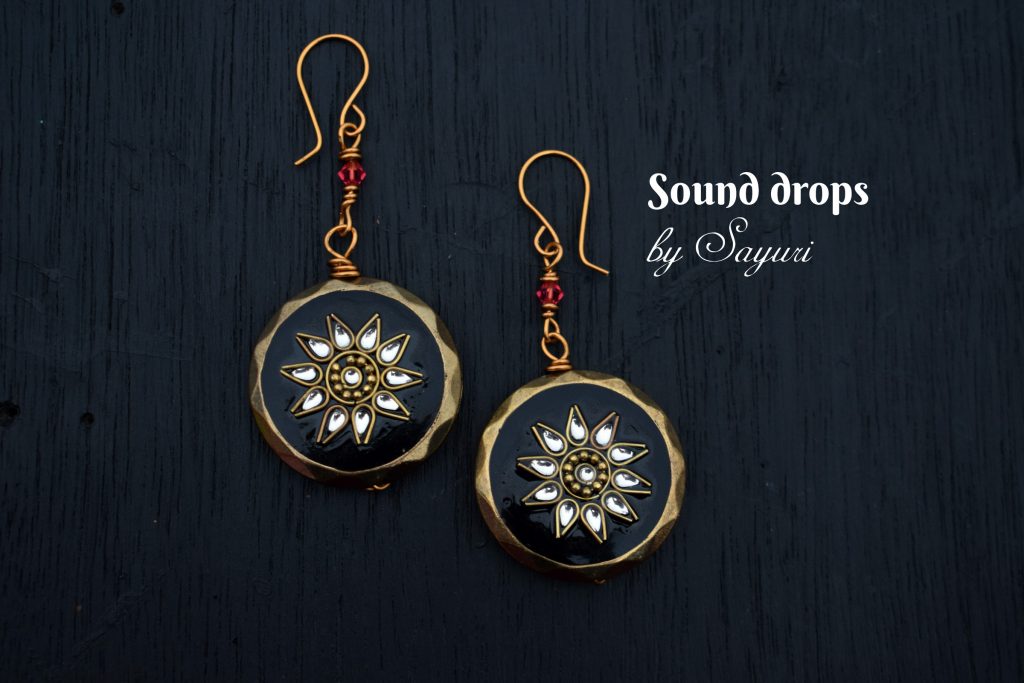We’re all ears Challenge for July is all about sound and visualisation of sound. For my Valentine’s day post, this year, I had written a post based on Sound visualiation and music inspired jewelry. In that post I had selected a song based on a classical carnatic raga(node) NataBhairavi and attempted to visualise it into jewelry. I had chosen the song vaseegara and had made a necklace following the sound to visual design process. Though it was an elaborate process, I loved actually using a process that I taught in class as a technique to create jewelry.
However, for the earrings everyday post, Erin has made it simpler by offering visualisation videos of classical composition. The participants have to use one or more videos as the inspiration for their earrings.
Strangely, I found this exercise hard as it was the visual description was limiting. Most of the videos focussed only on one dimension of the tempo or pitch of the songs (mostly the rhythm sequence). So I decided to challenge myself to see if I could unlearn the textbook design process and look at this challenge from a new perspective. I picked Moonlight Sonata by Beethovan on a whim.
Direct Interpretation
The Design school realisation of an inspiration is always indirect. We are taught (and we teach) that more indirect the interpretation the more interesting the output would be. Direct interpretation is usually frowned upon. Regular readers of this blog would have found several instances in the past (challenge posts) where I had done so. In my process of unlearning, I let go of this methodology and picked exactly what I saw in the video as my elements.
The visualisation comprised of dots and lines with circles and teardrops. The angle and velocity of the dashed lines emerging from the center make them appear like teardrops to me. Retaining the circle as the base line for my designs, I picked components which either have a rim or a circle within a circle design in them. I chose the colors black, red, white and gold (from the aura of the dots). Instead of the bright blue, I picked an earthy brown to balance the other colours.

Sound drop earrings
I wanted to highlight the circle and the sound ways hitting us in a sort of splashing action in a radial arrangements. That is, I took the horizontal imagery of the video and made it vertical in my mind and I asked myself the following questions. What if the sound is dropped to the ground from above – like a water droplet. If the teardrops (due to gravity) create a splashing motion on the ground, will it add to the original sound and make it somewhat denser? To represent this I created two pairs of “sound drop” earrings. I used black polki on plastic focals and red swarovski crystals for the first one and wooden buttons with polki for the second.
The word polki is typically used to define an uncut diamond but over the course of time has been used to name any transparent uncut cabochon. These are a part of a new collection that I am working on. Tentatively titled “Polki on Plastic“, ( looking for better titles obviously) it is collection of fun jewelry, pocket friendly incorporating traditional Indian patterns and embellishments. Both the pairs are made using orange- gold artistic wire as an accent to the dull gold of the components.

After I finished making the earrings, I revisited the recommended Youtube channels and scrolled through all the videos. I found other sound visualisations that were more visual and interesting to interpret. I felt a tang of irritation that I hadn’t previously taken the time to go through these videos. Had I done so, I felt the scope of my designs would have been more interesting. But then, going down this route I learnt that I could still produce new and unique designs if I change the way I look at direct inspiration.
Do visit the challenge page to see what the other participants have made. If you want to try out the sound to visual process, you can try this exercise I mentioned in the Vaseegara post.
Tell me in the comments, do you visualise sound? If so what do you see? Can jewelry be created out of this visualization?
I hope you found it interesting
Cheers



Leave a Reply